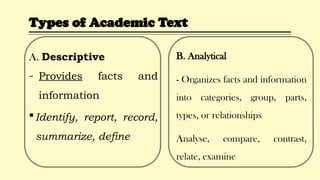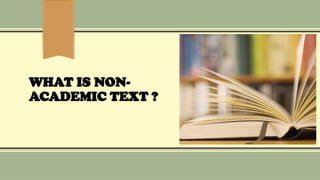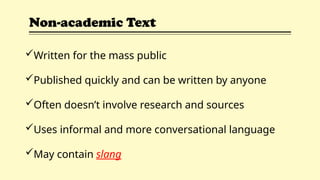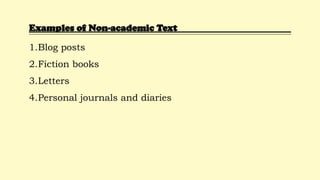Reading Academic Text Powerpoint Presentation
- 1. ENGLISH FOR ACADEMIC AND PROFESSIONAL PURPOSES Reading Academic Text (Academic and Non-academic Texts) Prepared by: Rachel O. Encinas, LPT SHS ŌĆō English Teacher
- 2. Learning Objectives: ’ā╝ Distinguish the difference between academic and non-academic texts; ’ā╝ Enumerate the different types of academic and non-academic texts; ’ā╝ Determine the purpose of reading academic text; and ’ā╝ Identify the factors to consider in academic writing
- 3. Directions: Categorize the information based on their characteristics below by filling in the table to differentiate academic text from non-academic text. Write your answer on a separate sheet of paper. ’é¦ Everyday Events ’é¦ To inform and/or validate idea ’é¦ To entertain ’é¦ Scholarly audience ’é¦ Contains slang and colloquialisms ’é¦ Subjective ’é¦ Related literature ’é¦ Introduction-Body-Conclusion ’é¦ No fixed structure ’é¦ Research papers, Reports ’é¦ Diaries, Informal essays ’é¦ Objective ’é¦ Public ’é¦ Formal
- 6. ACADEMIC TEXT ’ā╝ Written language that provides information, which contain ideas and concepts that are related to a particular discipline ’ā╝ Written by a professional ’ā╝ Well-edited and often take years to publish ’ā╝ Uses formal language
- 7. ’ā╝ Contain words and terms specific to a certain field ’ā╝ Contains list of sources and references ’ā╝ Main goal is to advance human understanding in a particular discipline ’ā╝ Can be challenging for novice or beginner ’ā╝ Informative, argumentative or objective in nature.
- 8. Examples of Academic Text 1. Journal articles 2. School books and textbooks 3. Research proposals and papers 4. Some newspapers and magazine articles 5. Thesis and Dissertation
- 9. Types of Academic Text A. Descriptive - Provides facts and information ’é¦Identify, report, record, summarize, define B. Analytical - Organizes facts and information into categories, group, parts, types, or relationships Analyse, compare, contrast, relate, examine
- 10. Types of Academic Text C. Persuasive - Includes argument, recommendation, interpretation, or evaluation of the work of others with the addition of your own point of view. - Needs to be supported by evidence Argue, evaluate, discuss, take a position D. Critical - Requires you to consider at least two point of view , including your own Critique, debate, disagree, and evaluate
- 11. WHAT IS NON- ACADEMIC TEXT ?
- 12. Non-academic Text ’ā╝Written for the mass public ’ā╝Published quickly and can be written by anyone ’ā╝Often doesnŌĆÖt involve research and sources ’ā╝Uses informal and more conversational language ’ā╝May contain slang
- 13. Non-academic Text ’ā╝Author may be unknown ’ā╝Usually delivers simple and basic information ’ā╝Can be easily read and understood by any kind of reader ’ā╝Personal, emotional, impressionistic, and subjective in nature.
- 14. Examples of Non-academic Text 1.Blog posts 2.Fiction books 3.Letters 4.Personal journals and diaries
- 15. PURPOSES IN READING AN ACADEMIC TEXT
- 16. ’ā╝ To locate a main idea. ’ā╝ To scan for information. ’ā╝ To identify gaps in existing studies.
- 17. ’ā╝To connect new ideas to existing ones. ’ā╝To gain more pieces of information. ’ā╝To support a particular writing assignment. ’ā╝To deeply understand an existing idea.
- 18. FACTORS TO CONSIDER IN WRITING ACADEMIC TEXT
- 19. 1. State critical questions and issues; 2. Provide facts and evidence from credible sources;
- 20. 3. Use precise and accurate words while avoiding jargon; 4. Take an objective point of view;
- 21. 5. List references; and, 6. Use cautious language.
- 22. Group Task!
- 23. Quiz#1A: Directions: Write ŌĆ£TŌĆØ if the statement is True and write ŌĆ£FŌĆØ if the statement is False. _____1. Academic Text may be considered that writing which is personal, emotional, impressionistic, or subjective in nature. _____2. Blog posts, fiction books, letters and personal journals or diaries are examples of Non- Academic Text. _____3. Introduction usually depicts the background of the topic and the central focus of the study. _____4. Structure is not important feature of academic writing. _____5. Academic Text is defined as critical, objective, specialized text written by experts or professionals in a given field using ŌĆ£formal languageŌĆØ
- 24. -END ’üŖ
Editor's Notes
- #1: NOTE: To change the image on this slide, select the picture and delete it. Then click the Pictures icon in the placeholder to insert your own image.























